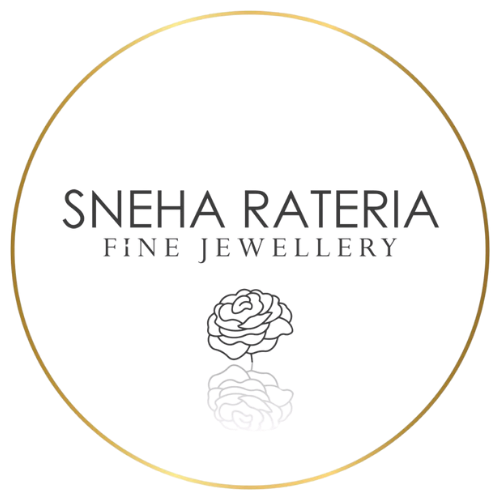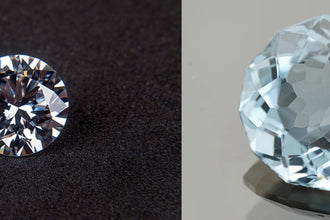
In this comprehensive guide, we will explore the fascinating history of cubic zirconia and examine its chemical composition and manufacturing process. By comparing Cubic Zirconia vs Diamond, we aim to provide you with valuable insights that will help you make an informed decision when selecting the ideal gemstone for your jewelry collection. Whether you are drawn to the brilliance of diamonds or the affordability of cubic zirconia, this guide will help you choose the perfect piece.
What is Cubic Zirconia?
Cubic Zirconia is a synthetic gemstone that closely resembles diamond in appearance but has significantly different properties. It is a crystalline form of zirconium dioxide, created in laboratories by carefully controlling the temperature, pressure, and composition during the manufacturing process.
Cubic Zirconia vs Diamond: What is the Difference?
Cubic Zirconia (CZ) and diamonds are both popular gemstones, but they differ significantly in various aspects. Here's a detailed comparison based on the specified points:
Creation
- CZ is a synthetic gemstone made from zirconium dioxide. It is produced in laboratories through a melting process that combines zirconium and zirconium oxide at high temperatures.
- Diamonds are natural gemstones formed from carbon under extreme pressure and heat deep within the Earth.
Facets and Cut
- CZ can be cut and polished to resemble diamonds, but it typically has more rounded edges and facets due to its softer nature.
- Diamonds are carefully shaped with sharp edges to make them shine brightly. The way a diamond is cut affects how much it sparkles and looks. The cut quality is very important for a diamond's beauty.
Chemical Structure
- Cubic Zirconia is composed of zirconium dioxide (ZrO2). CZ does not share the same chemical properties as diamonds.
- Diamond is composed almost entirely of carbon (C). Diamonds have a crystal structure that contributes to their hardness and brilliance.
Color Exposure
- CZ is a synthetic gemstone that can be made in many colors by adding certain chemicals during its creation. However, colorless CZ is the most common and is a clear sign that it is not a natural diamond.
- Diamonds come in many colors, from clear to yellow and brown, and even rare colors like blue and pink. Their colors are affected by tiny amounts of other elements and small flaws in their structure. These differences make each diamond unique.
Color Range
- CZ can be produced in a wide variety of colors, including vibrant hues that mimic colored diamonds.
- Diamond color range is graded on a scale from D (colorless) to Z (light yellow or brown), with many diamonds exhibiting subtle color variations.
Durability
- CZ has a hardness of about 8.5 on the Mohs scale, making it relatively durable but more prone to scratching compared to diamonds.
- Diamonds, with a hardness of 10 on the Mohs scale, are the hardest known natural material, making them highly resistant to scratches and damage.
Longevity/Life
- CZ can show signs of wear and may become cloudy or scratched over time, especially if not properly cared for.
- Diamonds are known for their longevity and can last a lifetime without significant wear, maintaining their brilliance and clarity.
Price or Cost
- CZ is significantly more affordable than diamonds, making it a popular choice for those seeking a diamond-like appearance without the high cost.
- Diamonds, especially natural ones, are expensive because they are rare. Mining and making them involves complicated steps. This combination of rarity and effort drives up their price.
History of Cubic Zirconia (CZ)
1930's: In 1937, German scientists M.V. Stackelberg and K. Chudoba discovered tiny grains of cubic zirconia within zircon crystals. However, they did not realize its importance at that time.
1960's: During the 1960s, researchers in France and the Soviet Union began exploring ways to create synthetic cubic zirconia crystals. Their goal was to find new materials for lasers and other optical technologies.
1970's: Soviet scientists developed a technique called the "skull crucible," which allowed them to melt and grow cubic zirconia crystals at the extremely high temperatures needed. This led to the commercial production of cubic zirconia starting in 1976.
1970's-1980's: Cubic zirconia quickly gained popularity as a diamond substitute due to its similar appearance, durability, and low cost. In the 1980s, Swarovski introduced its version of cubic zirconia, further boosting its popularity in jewelry.
How Is Cubic Zirconia Made?
Creating cubic zirconia is a captivating blend of science and artistry, transforming raw materials into brilliant, sparkling stones. Here's a step-by-step guide to how cubic zirconia is made:
Step 1: Procurement of Zirconium Dioxide
The primary ingredient for cubic zirconia is zirconium dioxide (ZrO2), a white crystal-like substance that is mined and cleaned to make it very pure. This key ingredient is needed to make cubic zirconia.
Step 2: Adding Stabilizing Agents
Pure zirconium dioxide can't form cubic crystals by itself at normal pressure. To keep its cubic shape, it needs help from other metal oxides like yttrium oxide or calcium oxide. These additives help prevent the crystal from changing back to a different shape as it cools down.
Step 3: Melting Process
Zirconium dioxide and stabilizing agents are heated in a special furnace, like an arc or induction furnace, at very high temperatures of about 4,982°F (2,750°C). This heat melts the materials and mixes them together into a smooth, uniform liquid.
Step 4: Crystal Growth
After the mixture melts, it cools down slowly to form crystals. This careful cooling is important because it helps the crystals grow properly and reduces defects. Different methods, like the skull melt or flux growth, can be used to improve the quality of the final crystals.
Step 5: Cutting and Polishing
After the crystals harden, they are shaped into gemstones by skilled cutters. They use special tools to carefully cut the cubic zirconia, making sure each side is perfectly aligned to reflect light beautifully. Finally, the stones are polished to a shiny finish, ready to be used in jewelry.
Step 6: Quality Control
Cubic Zirconia stones go through strict tests to check their clarity, color, cut, and weight. Any issues are found and fixed. Only the best stones are chosen for jewelry.
Step 7: Color Enhancement
Cubic zirconia is usually clear, but it can be made in different colors. This is done by adding tiny amounts of metal during its growth or by coating the finished stones with thin layers of metals. These methods make cubic zirconia colorful and attractive.
This intricate process results in the stunning cubic zirconia stones that are cherished in the world of jewelry.
Pros and Cons of Cubic Zirconia
Pros:
- Affordability: Much cheaper than diamonds.
- Appearance: Can closely resemble diamonds when cut well.
- Availability: Comes in many colors and cuts.
- Flawless Clarity: Can be produced without natural flaws.
Cons:
- Durability: Softer than diamonds and more prone to scratches.
- Lifespan: Typically lasts only a few years before showing wear.
- Resale Value: Has little to no resale value.
- Perceived Quality: Often seen as a "fake" diamond alternative.
How to Take Care of Cubic Zirconia
Here's a guide to taking care of your cubic zirconia jewelry in just a few key points:
- Regular Cleaning: Clean every two weeks with mild soap and warm water. Soak for 10 minutes and scrub gently with a soft toothbrush.
- Proper Rinsing and Drying: Rinse under warm water and pat dry with a microfiber cloth.
- Safe Storage: Store separately in soft pouches to avoid scratches.
- Avoid Harsh Chemicals: Stay away from ammonia, bleach, and abrasive cleaners.
- Limit Exposure: Remove jewelry before swimming or engaging in physical activities.
- Protect from Humidity: Keep in a dry place to maintain brilliance.
Conclusion
Cubic Zirconia stands out as a remarkable gemstone that combines affordability, beauty, and versatility. While it may not match the hardness and longevity of diamonds, its appeal lies in its flawless clarity and vibrant color options. Whether you're drawn to its cost-effectiveness or its sparkling resemblance to diamonds, CZ continues to be a popular choice for jewelry enthusiasts worldwide. By understanding its properties and learning how to care for it properly, you can enjoy the enduring elegance of Cubic Zirconia in your collection for years to come.
FAQs
1. Are lab-grown diamonds real diamonds?
Yes, lab-grown diamonds are real diamonds, chemically and physically identical to natural diamonds.
2. How are lab-grown diamonds created?
They are produced using two primary methods: High Pressure High Temperature (HPHT) and Chemical Vapor Deposition (CVD).
3. Can cubic zirconia be mistaken for diamonds?
Yes, cubic zirconia can closely resemble diamonds but lacks the hardness and brilliance of real diamonds.
4. Are lab-grown diamonds available in different colors?
Yes, lab-grown diamonds can be produced in various colors, including pink, blue, and yellow, through controlled processes.
5. Can jewelers tell if a diamond is lab-created?
Most jewelers may not be able to distinguish lab-created diamonds from natural ones without specialized equipment.
6. Are there any certifications for cubic zirconia?
Cubic zirconia does not have formal certifications like diamonds, but reputable sellers will provide information on quality and origin.
7. How do I know if a diamond is lab-grown?
Look for a grading report from a reputable gemological lab that specifies whether the diamond is lab-grown or natural.
8. What is the lifespan of cubic zirconia?
Cubic zirconia can last several years but may scratch or lose its brilliance over time, unlike diamonds which can last a lifetime.
9. Can lab-grown diamonds be used in engagement rings?
Absolutely! Lab-grown diamonds are a popular choice for engagement rings due to their beauty and ethical considerations.
10. Can cubic zirconia be recut or repurposed?
Yes, cubic zirconia can be recut or repurposed, but it is less common due to its lower value compared to diamonds.







